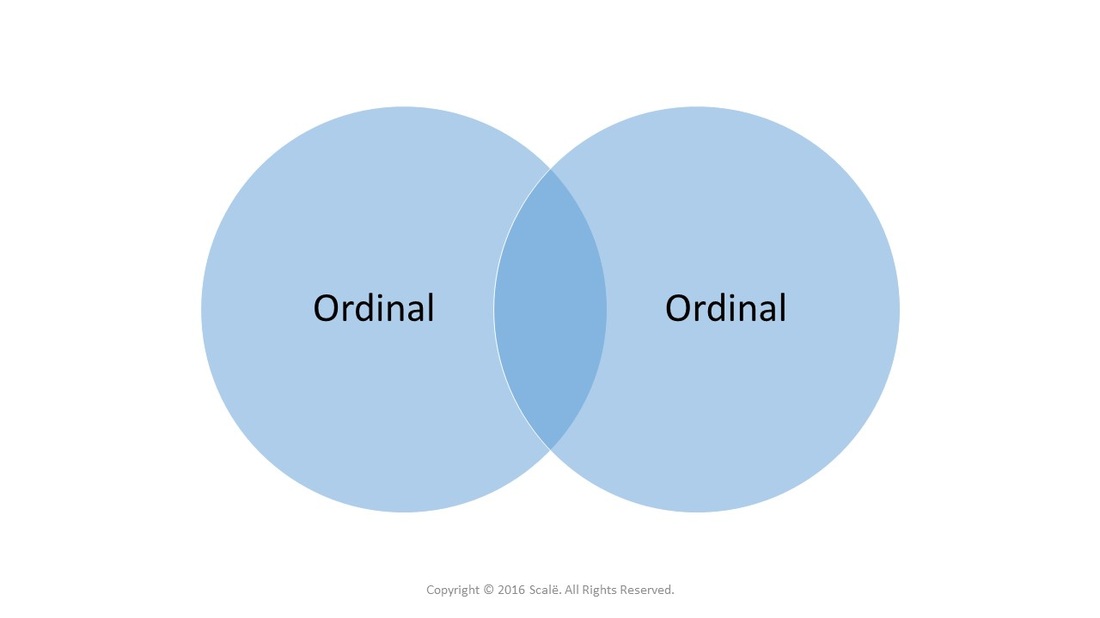Spearman's rho
Correlation between two ordinal variables
Spearman's rho is the correlation used to assess the relationship between two ordinal variables. Spearman's rho is a popular method for correlating unvalidated survey instruments or Likert-type survey responses. Spearman's rho is prevalent in the social sciences as most survey instruments use Likert-type or ordinal scales to allow participants to rate themselves along a continuum. Run skewness and kurtosis statistics on each variable's distribution. If the assumption of normality can be met, then more powerful biserial or Pearson correlations can be used instead of Spearman's rho.
The Venn diagram below depicts the correlation of two ordinal variables. Spearman's rho is the correlation test used when testing the relationship between two ordinal variables.
The steps for conduct a Spearman's rho correlation in SPSS
1. The data is entered in a within-subject fashion.
2. Click Analyze.
3. Drag the cursor over the Correlate drop-down menu.
4. Click on Bivariate.
5. Click on the first ordinal outcome variable to highlight it.
6. Click on the arrow to move the variable into the Variables: box.
7. Click on the second ordinal outcome variable to highlight it.
8. Click on the arrow to move the variable into the Variables: box.
9. Click on the Pearson box to deselect it.
10. Click on the Spearman box to select it.
11. Click OK.
2. Click Analyze.
3. Drag the cursor over the Correlate drop-down menu.
4. Click on Bivariate.
5. Click on the first ordinal outcome variable to highlight it.
6. Click on the arrow to move the variable into the Variables: box.
7. Click on the second ordinal outcome variable to highlight it.
8. Click on the arrow to move the variable into the Variables: box.
9. Click on the Pearson box to deselect it.
10. Click on the Spearman box to select it.
11. Click OK.
The steps for interpreting the SPSS output for a Spearman's rho correlation
1. In the Correlations table, match the row to the column between the two ordinal variables. The Correlation Coefficient is the actual correlation value that denotes magnitude and direction, the Sig. (2-tailed) is the p-value that is interpreted, and the N is the number of observations that were correlated.
If the p-value is LESS THAN .05, then researchers have evidence of a statistically significant bivariate association between the two ordinal variables.
If the p-value is MORE THAN .05, then researchers have evidence that there is not a statistically significant association between the two ordinal variables.
Higher rho coefficients denote a stronger magnitude of relationship between variables. Smaller rho coefficients denote weaker relationships.
Positive correlations denote a relationship that travels at the same trajectory. As one value goes up, then the other value goes up. Also, as one value goes down, then the other value goes down too.
Negative correlations denote a relationship that travels in different directions. As one value goes up, the other value goes down. Also, as one value goes down, then the other value goes up.
If the p-value is LESS THAN .05, then researchers have evidence of a statistically significant bivariate association between the two ordinal variables.
If the p-value is MORE THAN .05, then researchers have evidence that there is not a statistically significant association between the two ordinal variables.
Higher rho coefficients denote a stronger magnitude of relationship between variables. Smaller rho coefficients denote weaker relationships.
Positive correlations denote a relationship that travels at the same trajectory. As one value goes up, then the other value goes up. Also, as one value goes down, then the other value goes down too.
Negative correlations denote a relationship that travels in different directions. As one value goes up, the other value goes down. Also, as one value goes down, then the other value goes up.
Click on the Download Database and Download Data Dictionary buttons for a configured database and data dictionary for Spearman's rho. Click on the Adjusing for Multiple Comparisons button to learn more about Bonferroni, Tukey's HSD, and Scheffe's test. Click on the Validation of Statistical Findings button to learn more about bootstrap, split-group, and jack-knife validation methods.
Hire A Statistician
DO YOU NEED TO HIRE A STATISTICIAN?
Eric Heidel, Ph.D., PStat will provide you with statistical consultation services for your research project at $100/hour. Secure checkout is available with Stripe, Venmo, Zelle, or PayPal.
- Statistical Analysis on any kind of project
- Dissertation and Thesis Projects
- DNP Capstone Projects
- Clinical Trials
- Analysis of Survey Data

